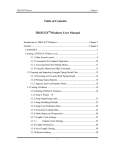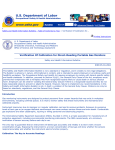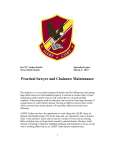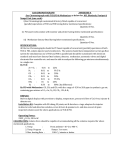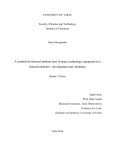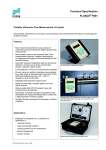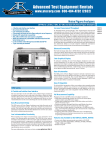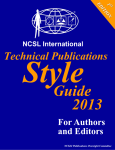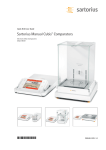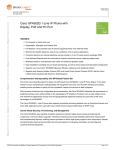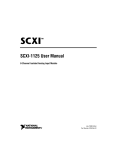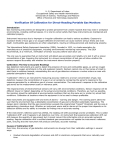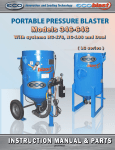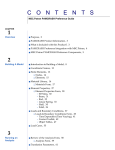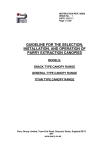Download OSHA Calibration Frequency Bulletin
Transcript
What's New | Offices Menu Occupational Safety & Health Administration We Can Help Safety and Health Information Bulletins / Calibrating and Testing Direct-Reading Portable Gas Monitors U.S. Department of Labor Occupational Safety and Health Administration Directorate of Technical Support and Emergency Management Office of Science and Technology Assessment Calibrating and Testing Direct-Reading Portable Gas Monitors Safety and Health Information Bulletin SHIB 09-30-2013 This Safety and Health Information Bulletin is not a standard or regulation, and it creates no new legal obligations. The Bulletin is advisory in nature, informational in content, and is intended to assist employers in providing a safe and healthful workplace. Pursuant to the Occupational Safety and Health Act, employers must comply with hazard-specific safety and health standards and regulations promulgated by OSHA or by a state with an OSHAapproved state plan. In addition, pursuant to Section 5(a)(1), the General Duty Clause of the Act, employers must provide their employees with a workplace free from recognized hazards likely to cause death or serious physical harm. Employers can be cited for violating the General Duty Clause if there is a recognized hazard and they do not take reasonable steps to prevent or abate the hazard. However, failure to implement any recommendations in this Safety and Health Information Bulletin is not, in itself, a violation of the General Duty Clause. Citations can only be based on standards, regulations, and the General Duty Clause. The information in this Safety and Health Information Bulletin (SHIB) provides workers and employers guidance on calibrating and testing direct-reading portable gas monitors (hereafter, "DRPGMs" or "instruments"). These instruments protect workers from unseen workplace gas hazards. Proper maintenance and calibration of the instruments ensures their accuracy in detecting worker exposure to harmful gases in the workplace. Follow the manufacturer's recommendations with regard to calibrating the instruments. Introduction DRPGMs are designed to alert workers to toxic gases, as well as oxygen-deficient and combustible atmospheres that may exist in their workplace environments, such as permit-required confined spaces, manholes, and other enclosed spaces. Several OSHA standards require the use of gas monitors. See paragraph (c)(5) (ii)(C) of 29 CFR 1910.146 (Permit-required confined spaces); paragraph (c)(6) of 29 CFR 1910.120 (Hazardous waste operations and emergency response); and section 5 (Entry into bins, silos, and tanks) of Appendix A of 29 CFR 1910.272 (Grain handling facilities). OSHA recommends developing standard procedures for calibrating and using DRPGMs that include documentation to verify the proper maintenance and calibration of the instruments. Instrument inaccuracy due to improper or irregular maintenance and calibration can lead to exposure to hazardous levels of toxic gases or to an oxygen-deficient atmosphere. This exposure can cause workers to suffer serious injuries or illness, and even death. Flammable gas explosions are often catastrophic, resulting in worker injuries and death, or destruction of property. The best way to verify that a DRPGM detects gas accurately and reliably is to test it with a known concentration of gas. This procedure will verify whether the sensors in the instrument respond accurately and whether the alarms function properly. The International Safety Equipment Association (ISEA), founded in 1933, is a trade association for manufacturers of protective equipment, including DRPGMs. The ISEA recommends, at a minimum, verifying the operational capability of these instruments before each day's use, with additional testing conducted as necessary. This SHIB incorporates recommendations developed by the ISEA.1 Calibration: The Key to Accurate Readings Operators use DRPGMs to detect the presence and concentration of toxic and combustible gases, as well as oxygen deficiency or oxygen enrichment (which is a fire and explosion hazard). Workers must not rely solely on their sense of smell to alert them to these hazards. Employers should ensure that workers use these instruments when working in areas with potential hazardous atmospheres. "Calibration" refers to an instrument's measuring accuracy relative to a known traceable concentration of test gas. DRPGMs compare the sensor's response to a known concentration of the test gas. To confirm the validity of this comparison, it is important to ensure the calibration gas has not expired (always check the expiration date of the gas before usage). The instrument's response to the calibration gas serves as the reference point. The responsiveness of sensors will vary with workplace environmental conditions, such as temperature and humidity. Therefore, to the degree possible, operators should calibrate sensors in environmental conditions that are the same as (or similar to) the actual workplace conditions. Follow the manufacturer's guidelines for proper calibration. Standard procedures for regular calibration that conform to the manufacturer's instructions, internal company policy, and/or the appropriate regulatory agency guidelines will help to ensure that calibration procedures are readily followed by the DRPGM operators, and that the instruments are operable and accurate when used. Employers should keep calibration records for the life of each instrument. This record enables operators to quickly identify a DRPGM that has a history of excessive maintenance/repair, or is prone to erratic readings, and to track drift of the sensors to determine when they need replacement. Calibration Drift and Causes When an instrument's reference point shifts, the reading will shift accordingly and be unreliable. This is called "calibration drift," and it happens to all sensors over time. An instrument that experiences calibration drift can still measure the quantity of gas present, but it cannot convert this information into an accurate numerical reading. Calibration checks or full calibration2 with a traceable gas concentration will verify or update the instrument's reference point. Operators should conduct these procedures daily, or more frequently if needed, to ensure that the instrument will continue to produce accurate readings. Calibration drift occurs most often because of: Degradation caused by exposure to phosphates Degradation of phosphorus-containing components Degradation of lead-containing components Gradual chemical degradation of sensors and drift in electronic components that occur normally over time. Use in extreme environmental conditions, such as high/low temperature and humidity, and high levels of airborne particulates. Exposure to high concentrations of the target gases and vapors. Exposure of catalytic hot-bead LEL sensors in the instruments to volatile silicones, hydride gases, halogenated hydrocarbons, and sulfide gases. Exposure of electrochemical toxic gas sensors to solvent vapors and highly corrosive gases. Handling/jostling of the equipment causing enough vibration or shock over time to affect electronic components and circuitry. Operators should validate a DRPGM's operability when any of these conditions occurs, or is suspected, during use. When attempting to calibrate an instrument after exposure to these conditions, the sensor often will either display a failure message or will not allow the operator to fully adjust the display reading. Harsh operating and storage conditions can affect instrument performance, leading to inaccurate readings or even failure. While a DRPGM may appear undamaged during visual inspection, it actually could be damaged internally. At this point, the operator should replace the damaged sensor or have qualified personnel service the sensor. Be sure to follow the manufacturer's instructions regarding sensor replacement and servicing. Worker Safety: The Number One Reason for Proper and Regular Calibration The primary reason for proper, regular instrument calibration is to provide accurate gas-concentration readings that could prevent worker illness, injury, or death. Correctly calibrating an instrument helps to ensure that the DRPGM will respond accurately to the gases it is designed to detect, thereby warning users of hazardous conditions before the conditions reach dangerous levels. Some DRPGMs have two levels of alarms – warning and danger. The warning alarm alerts the operator and workers that the work environment has a detectable elevated concentration of toxic gas and is, therefore, potentially hazardous. The danger alarm indicates that the toxic-gas concentration exceeds the programmed hazard threshold, and that the toxic gas in the work area is above the warning level and approaching a hazardous level. Whether a DRPGM provides a warning or danger alarm at the proper concentration depends on its detection capabilities, its ability to translate its findings into an accurate reading, and the presence of interfering gases (see "Calibration Drift and Causes" above). Bump Tests, Calibration Checks, and Full Calibration Bump Test (or Function Check) This is a qualitative function check in which a challenge gas is passed over the sensor(s) at a concentration and exposure time sufficient to activate all alarm settings. The purpose of this check is to confirm that gas can get to the sensor(s) and that all the instrument's alarms are functional. The bump test or function check does not provide a measure of the instrument's accuracy. When performing a bump test, the challenge gas concentration should trigger the DRPGM's alarm(s). Calibration Check or Full Calibration There are two methods for verifying DRPGM accuracy: a calibration check and a full calibration. Each method is appropriate under certain conditions. A calibration check verifies that the sensor(s) and alarms respond within the manufacturer's acceptable limits by exposing the instrument to a test gas. The operator compares the reading to the test-gas concentration (as indicated on the cylinder containing the test gas). If the instrument's response is within the acceptable range of the test-gas concentration (typically ± 10-20% of the test-gas concentration), then the calibration check verified the instrument's accuracy. (Note: OSHA recommends that operators check with the instrument's manufacturer for the acceptable tolerance ranges.) An operator should "zero" an instrument (reset the reference point, in some cases "zero air" gas may be needed) before conducting the calibration check to ensure that the calibration check results are accurate. When performing a calibration check, the test-gas concentration should be high enough to trigger the instrument's alarm(s). If the calibration-check results are not within the acceptable range, the operator should perform a full calibration. A full calibration adjusts the instrument's reading to coincide with a known concentration (i.e., certified standard) of test gas. Test gas used for calibration gas should always be certified using a standard traceable to the National Institute of Standards and Technology (NIST).3 When to Perform a Bump Test and When to Perform a Full Calibration In the past, there has been some confusion regarding proper calibration procedures and frequency. To clarify this issue, ISEA updated its position statement on instrument calibration in 2010, stating, "A bump test . . . or calibration check of portable gas monitors should be conducted before each day's use in accordance with the manufacturer's instructions." If an instrument fails a bump test or a calibration check, the operator should perform a full calibration on it before using it. If the instrument fails the full calibration, the employer should remove it from service. Contact the manufacturer for assistance or service. Calibration Rules The following are a few basic calibration rules for DRPGMs: Follow the manufacturer's guidelines for proper calibration. Operators cannot perform any job, including DRPGM calibration, properly or safely without the right tools. The type and concentration of calibration test gas, sample tubing, flow regulators, and calibration adapters are key links in the calibration chain. Operators should conduct any testing to verify the operation of the gas monitor in an environment that is the same as (or similar to) the working conditions (e.g., temperature, humidity, atmospheric pressure). Only use a certified traceable test gas, and do so before its expiration date. The instrument can only be as accurate as the test gas used to calibrate it. Be certain that the supplier can provide a certificate of analysis for every test-gas cylinder. The concentration of the test gas, particularly reactive gases such as hydrogen sulfide and chlorine, will only remain stable for a limited period. Never use a test gas after its expiration date. Train DRPGM operators on the proper methods of calibration. Most instruments are designed to be field calibrated with detailed instructions provided in the manufacturer's user manual, training videos, or computer-based training modules. Employers should train and test everyone responsible for performing DRPGM calibration. Conclusion Many workplaces have a risk of injury, illness, or death from respiratory hazards such as oxygen deficiency and the combustible or toxic gases. DRPGM technology and products exist to minimize such risks. Properly verifying the function and accuracy of instruments before each day's use will help to ensure that each worker finishes the job safely. For more information contact OSHA at: 1-800-321-6742 (OSHA) – OSHA Main Number www.osha.gov Twenty-seven states and territories operate their own occupational safety and health programs approved by OSHA. States enforce similar standards that may have different or additional requirements. A list of state plans is available at http://www.osha.gov/dcsp/smallbusiness/index.html OSHA's On-site Consultation Program offers free and confidential advice to small and medium-sized businesses in all states across the country, with priority given to high-hazard worksites. On-site Consultation Programs are separate from enforcement and do not result in penalties or citations. To locate the OSHA On-site Consultation Program nearest you, call 1-800-321-6742 (OSHA) or visit http://www.osha.gov/dcsp/smallbusiness/index.html. On-Line Resources: International Safety Equipment Association (ISEA) 1901 North Moore Street Arlington, VA 22209-1762 (703) 525-1695 http://www.safetyequipment.org (OSHA Alliance 2003-2005) ISEA Statement on Validation of Operation for Direct Reading Portable Gas Monitors: http://www.safetyequipment.org/userfiles/file/calibration_statement-2010-mar4.pdf (PDF) Footnotes 1 See link to the "ISEA Statement on Validation of Operation for Direct Reading Portable Gas Monitors" at the end of this SHIB. 2 See the discussion of calibration checks and full calibration later in this SHIB. 3 The "Supplementary Materials for NIST Policy Review" page on NIST's website at http://www.nist.gov/traceability/suppl_matls_for_nist_policy_rev.cfm following definition of "traceable to NIST": "According to the internationally recognized VIM (accessed 08/15/2013) provides the definition, metrological traceability is a property of a measurement result by which that result is related to specified reference standards, not to institutions. Accordingly, the phrase 'traceable to NIST,' in its most proper sense, is shorthand for 'metrologically traceable to NIST's practical realization of the definition of a measurement unit' (see 2.43 in [JCGM 200:2008, International vocabulary of metrology - Basic and general concepts and associated terms (VIM Third Edition, 2008)]." *Accessibility Assistance: Contact OSHA's Directorate of Science, Technology and Emergency Management at (202) 639-2300 for assistance accessing PDF materials. All other documents, that are not PDF materials or formatted for the web, are available as Microsoft Office® formats and videos and are noted accordingly. If additional assistance is needed with reading, reviewing or accessing these documents or any figures and illustrations, please also contact OSHA's Directorate of Science, Technology and Emergency Management at (202) 639-2300. **eBooks - EPUB is the most common format for e-Books. If you use a Sony Reader, a Nook, or an iPad you can download the EPUB file format. If you use a Kindle, you can download the MOBI file format.




